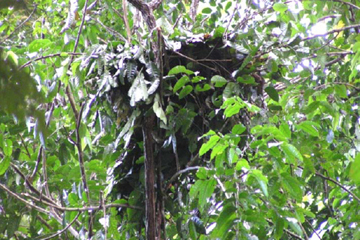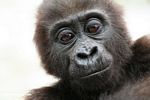How do you count orangutans when they are difficult to spot in the wild given that they are shy, arboreal, and few and far between? To find a solution, biologists have turned to estimating orangutan populations by counting their nests, which the great apes make anew every night. In order to make the most accurate count possible, researchers have studied the different factors that could impact the success, or lack thereof, of nest-counters in mongabay.com’s open access journal Tropical Conservation Science.
“We analyze the effect of several factors (distance to [line] transect, height, decay stage, and observer experience) on the probability that a [Sumatran] orangutan (Pongo abelii) nest is found along a line transect. The results indicate that all factors significantly influence nest detection,” the researchers write. Line transect is a simple survey technique to measure abundance along a specified ‘line’ in the forest, in this case the line measured 1.5 kilometers of land in Sumatra’s Gunung Leuser National Park.
 Orangutan nest in Gunung Leuser National Park. Photo by: Serge Wich. |
The study followed six teams’ results in counting nests, and found that on average teams missed 11% of the total nests. Not surprisingly, the most experienced teams sighted the most nests, while the higher the nest in the canopy the more likely it would be missed.
The study suggests that one of the best ways to avoid errors in density is to decrease the width of the line transect.
“Restricting the transect width could have effects similar to using much more experienced sampling teams, and the surveys may, in some circumstances, be much easier to do,” the authors conclude.
CITATION: Wich, S. A. and Boyko, R. H. 2011. Which factors determine orangutan nests’ detection probability along transects? Tropical Conservation Science Vol. 4 (1):53-63.
Related articles
Primatologists: the best hope for apes is the best hope for us

The problem-solving ape: what makes orangutans special and why they are threatened
 (12/13/2010) Michelle Desilets, Executive Director of the Orangutan Land Trust, spoke with Laurel Neme on her “The WildLife” radio show and podcast about orangutans. In the first part of her interview, they discussed orangutan biology, habits and the interconnected threats, from the pet trade to habitat loss and expansion of oil palm plantations, facing these creatures. The second part covers the process of rehabilitating orangutans and teaching them to
(12/13/2010) Michelle Desilets, Executive Director of the Orangutan Land Trust, spoke with Laurel Neme on her “The WildLife” radio show and podcast about orangutans. In the first part of her interview, they discussed orangutan biology, habits and the interconnected threats, from the pet trade to habitat loss and expansion of oil palm plantations, facing these creatures. The second part covers the process of rehabilitating orangutans and teaching them to
Orangutans can survive in timber plantations, selectively logged forests
(09/23/2010) Selectively logged forests and timber plantations can serve as habitat for orangutans, suggesting that populations of the endangered ape may be more resilient than previously believed, reports research published in the journal PlosONE. The study, conducted by a team of researchers led by Erik Meijaard of Jakarta-based People and Nature Consulting International, found roughly equivalent population densities between natural forest areas and two pulp and paper plantation concessions in East Kalimantan, Indonesian Borneo.